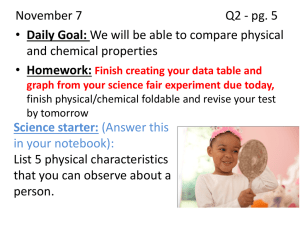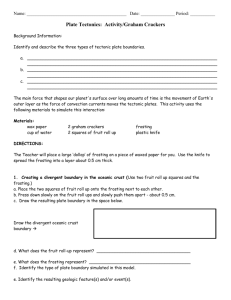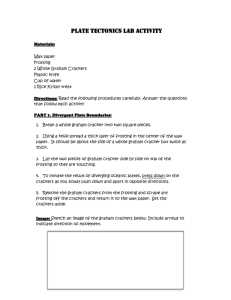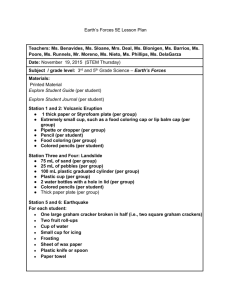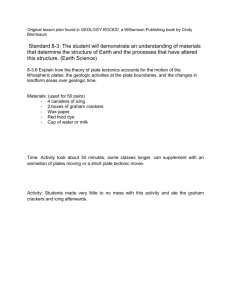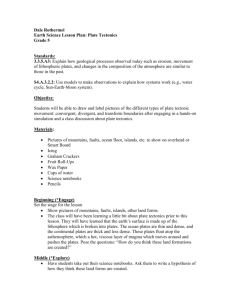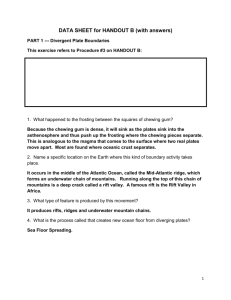Plate Tectonics - Science4Inquiry.com
advertisement
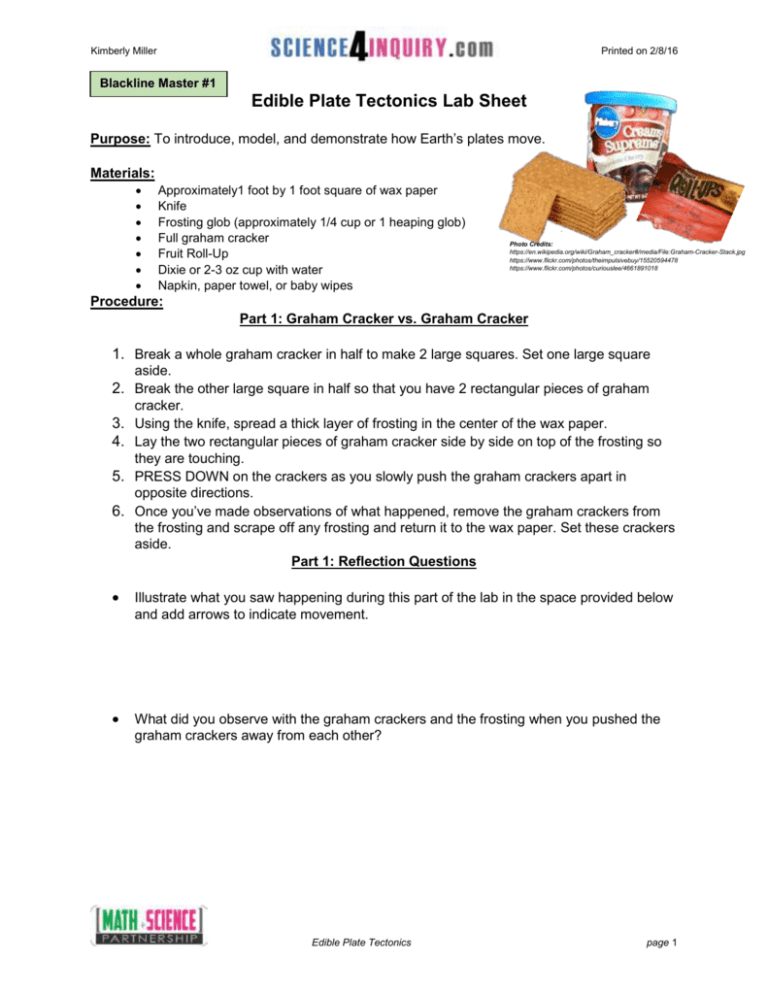
Kimberly Miller Printed on 2/8/16 Blackline Master #1 Edible Plate Tectonics Lab Sheet Purpose: To introduce, model, and demonstrate how Earth’s plates move. Materials: Approximately1 foot by 1 foot square of wax paper Knife Frosting glob (approximately 1/4 cup or 1 heaping glob) Full graham cracker Fruit Roll-Up Dixie or 2-3 oz cup with water Napkin, paper towel, or baby wipes Photo Credits: https://en.wikipedia.org/wiki/Graham_cracker#/media/File:Graham-Cracker-Stack.jpg https://www.flickr.com/photos/theimpulsivebuy/15520594478 https://www.flickr.com/photos/curiouslee/4661891018 Procedure: Part 1: Graham Cracker vs. Graham Cracker 1. Break a whole graham cracker in half to make 2 large squares. Set one large square 2. 3. 4. 5. 6. aside. Break the other large square in half so that you have 2 rectangular pieces of graham cracker. Using the knife, spread a thick layer of frosting in the center of the wax paper. Lay the two rectangular pieces of graham cracker side by side on top of the frosting so they are touching. PRESS DOWN on the crackers as you slowly push the graham crackers apart in opposite directions. Once you’ve made observations of what happened, remove the graham crackers from the frosting and scrape off any frosting and return it to the wax paper. Set these crackers aside. Part 1: Reflection Questions Illustrate what you saw happening during this part of the lab in the space provided below and add arrows to indicate movement. What did you observe with the graham crackers and the frosting when you pushed the graham crackers away from each other? Edible Plate Tectonics page 1 Part 2: Fruit Roll-Up vs. Fruit Roll-Up 1. Using the knife cut the Fruit Roll-Up in half. 2. Using the knife re-spread a thick layer of frosting in the center of the wax paper. 3. Lay the two pieces of Fruit Roll-Up side by side on top of the frosting so they are touching. 4. PRESS DOWN on the Fruit Roll-Ups as you slowly push down and apart in opposite directions. 5. Once you’ve made observations of what happened, remove the Fruit Roll-Ups from the frosting and scrape off any frosting and return it to the wax paper. Set the Fruit Roll-Ups aside. Part 2: Reflection Questions Illustrate what you saw happening during this part of the lab in the space provided below and add arrows to indicate movement. Compare and contrast part 2 and part 1. Part 3: Graham Cracker vs. Graham Cracker 1. Break the remaining two graham crackers in half (you should now have 4 pieces). Set the pieces to the side. 2. Using the knife re-spread a thick layer of frosting in the center of the wax paper. 3. Using only 2 pieces of cracker, dip one of the short ends of each of the two graham crackers into a cup of water for approximately 3 seconds. 4. Lay the pieces end to end on the frosting with the wet edges touching. 5. Slowly push the two crackers together. 6. Once you’ve made observations of what happened, remove the graham crackers from the frosting and scrape off any frosting and return it to the wax paper. Set these crackers aside. Part 3: Reflection Questions Illustrate what you saw happening during this part of the lab in the space provided below and add arrows to indicate movement. Describe what happened when you pushed the two graham crackers together. Edible Plate Tectonics page 2 Part 4: Graham Cracker vs. Graham Cracker 1. Using the knife re-spread a thick layer of frosting in the center of the wax paper. 2. Using the graham crackers from part 1 (not the soggy ones), place the two pieces together side by side on top of the frosting on the wax paper. The long edges of the graham crackers should be touching. 3. Place one hand on each of the graham cracker pieces. At the same time, move one graham cracker forward and one backward. 4. Once you’ve made observations of what happened, remove the graham crackers from the frosting and scrape off any frosting and return it to the wax paper. Set the graham crackers aside. Part 4: Reflection Questions Illustrate what you saw happening during this part of the lab in the space provided below and add arrows to indicate movement. Describe what happened when you slid the 2 graham crackers past each other. Part 5: Fruit Roll-Up vs. Graham Cracker: 1. Using the knife re-spread a thick layer of frosting in the center of the wax paper. 2. Using one of the graham cracker pieces and one of the Fruit Roll-Up pieces, place them on the frosting. 3. Gently push the graham cracker into the Fruit Roll-Up. 4. Once you’ve made observations of what happened, remove the Fruit Roll-Up and graham cracker from the frosting and scrape off any frosting and return it to the wax paper. Set the Fruit Roll-Up and graham cracker aside. Part 5: Reflection Questions Illustrate what you saw happening during this part of the lab in the space provided below and add arrows to indicate movement. Describe what happened when you slid the graham cracker into the Fruit Roll-Up. Edible Plate Tectonics page 3 Additional Reflection Questions 1. Why is what you did with the graham crackers, Fruit Roll-Ups, and frosting considered a “model” of plate tectonics? 2. Why do we use models in science? 3. Why was it beneficial (helpful) to use a model of the plates and the plate movement? 4. What were some of the limitations of this model? In other words, what are some things that this model cannot demonstrate about plate tectonics? 5. In your model, what did each of the parts of your model represent? Part of Model What it Represented Graham Crackers Fruit Roll-Ups Frosting 6. In this lab, we were able to show plate movement in a few seconds. Why is this not necessarily scientifically accurate? 7. Which type of geological processes might take a very short amount of time and which type might take thousands or millions of years. Edible Plate Tectonics page 4 Kimberly Miller Printed on 2/8/16 Blackline Master #2 Plate Tectonics Boundary Graphic Organizer Example Use your lab sheet to describe what you observed in each part. Part 1 Part 2 Part 3 Part 4 Part 5 I observed the graham cracker sliding past the other graham cracker and it getting stuck and crumbling at the edges. Based on your observations draw the movement using arrows. Which landforms or events are associated with this part? Faults and earthquakes What is the name of the plate tectonic boundary that this part models. Transform Boundary Edible Plate Tectonics page 5 Kimberly Miller Printed on 2/8/16 Blackline Master #3 Group-Pair-Share Organizer Divergent Boundary Convergent Boundary Edible Plate Tectonics Transform Boundary page 6 Kimberly Miller Printed on 2/8/16 Blackline Master #4 Concept Check: Plate Tectonics 1) Oceanic crust is denser than continental crust. Which of the following is most likely to happen when a plate carrying oceanic crust converges with a plate carrying continental crust? (SC.7.E.6.5) A. The plates collide and mantle convection stops B. The denser oceanic plate gradually sinks into the mantle and melts. C. Both the oceanic and the continental plates sink into the mantle and melt. D. The less dense continental plate gradually sinks into the mantle and melts. 2) Draw arrows in the boxes and identify the tectonic plate boundary that matches to the type of movement. (SC.7.E.6.5) 3) Directions: Match the tectonic boundary with the landform(s) that it creates: Convergent Boundary Mid-Ocean Ridge Volcano Divergent Boundary Deep Sea Trench Mountain Range Transform Boundary Rift Valley Fault 4) Jane states that the motion of the tectonic plates causes rapid (fast) changes. Steve states that the motion of the tectonic plates causes slow changes. Who is correct? (SC.7.E.6.5) A. Jane is correct because changes to Earth’s surface happen rapidly. B. Steve is correct because changes to Earth’s surface happen slowly. C. Neither are correct because changes happen at a moderate pace. D. Both of them are correct because some changes happen rapidly and some happen slowly. 5) Why would it be necessary to model plate tectonic processes? (SC.7.N.3.2) a. The processes happen under water so we don’t see them happening. b. The processes happen too fast for us to see them working together. c. The processes happen over too large of a geographic scale to accurately see them working together. d. The processes are too dangerous for us to see them working together. Edible Plate Tectonics page 7 Blackline Master #5 Kimberly Miller Printed on 2/8/16 As you look at the following images, reflect on your lab. Which of the plate movements would result in these landforms? Edible Plate Tectonics page 8 Kimberly Miller MOUNTAINS Printed on 2/8/16 Photo Credit: https://upload.wikimedia.org/wikipedia/commons/f/f0/Everest_North_Face_toward_Base_Camp_Tibet_Luca_Gal uzzi_2006_edit_1.jpg Photo Credit: https://upload.wikimedia.org/wikipedia/commons/c/c5/Moraine_Lake_17092005.jpg I. Himalayas Nepal and China Edible Plate Tectonics page 9 RIDGES Kimberly Miller Printed on 2/8/16 Photo Credit: https://commons.wikimedia.org/wiki/File:Ca%C3%B1%C3%B3n_Silfra,_Parque_Nacional_de_%C3%9Eingvellir,_Su%C3%B0ur land,_Islandia,_2014-0816,_DD_055.JPG#/media/File:Ca%C3%B1%C3%B3n_Silfra,_Parque_Nacional_de_%C3%9Eingvellir,_Su%C3%B0urland,_Isla ndia,_2014-08-16,_DD_055.JPG III. Mid-Atlantic Ridge Iceland Photo Credit: https://commons.wikimedia.org/wiki/File:Atlantic_bathymetry.jpg IV. Mid-Atlantic Ridge Edible Plate Tectonics Atlanticpage Ocean 10 Kimberly Miller Printed on 2/8/16 Edible Plate Tectonics page 11 Kimberly Miller FAULT LINE Printed on 2/8/16 Photo Credit: https://simple.wikipedia.org/wiki/San_Andreas_Fault Photo Credit: https://simple.wikipedia.org/wiki/San_Andreas_Fault V. San Andreas Fault California Edible Plate Tectonics page 12 Kimberly Miller RIFT VALLEY Printed on 2/8/16 Photo Credit: https://en.wikipedia.org/wiki/File:Browncanyonquilotoa.jpg VII. Rift Valley Quilotoa, Ecuador Photo Credit: https://upload.wikimedia.org/wikipedia/commons/4/42/NASA_-_Visible_Earth,_Lakes_of_the_African_Rift_Valley.jpg Edible Plate Tectonics VI. East African Rift Africa page 13 Kimberly Miller Printed on 2/8/16 Photo Credit: https://www.flickr.com/photos/cwkarl/17080327630 IX. Aogashima Volcano Japan Photo Credit: https://en.wikipedia.org/wiki/Arenal_Volcano#/media/File:CostaRica_Arenal_Volcano_%28pixinn.net%29.jpg VOLCANOES VIII. Arenal Volcano Costa Rica Edible Plate Tectonics page 14 Kimberly Miller Printed on 2/8/16 Photo Credit: https://en.wikipedia.org/wiki/Oceanic_trench#/media/File:Atlantictrench.JPG XI. Puerto Rico Trench Puerto Rico Photo Credit: https://en.wikipedia.org/wiki/Mariana_Trench#/media/File:Cross_section_of_mariana_trench.svg TRENCHES X. Mariana Trench Pacific Ocean Edible Plate Tectonics page 15 Kimberly Miller Printed on 2/8/16 Blackline Master #6 ANSWER KEYS Lab Sheet Answers Part 1: Reflection Questions Illustrate what you saw happening during this part of the lab in the space provided below and add arrows to indicate movement. What did you observe with the graham crackers and the frosting when you pushed the graham crackers away from each other? There was frosting left in the middle and some of it squished up between the graham crackers. The height of the graham cracker left a valley in between the two graham crackers. Part 2: Reflection Questions Illustrate what you saw happening during this part of the lab in the space provided below and add arrows to indicate movement. Compare and contrast part 2 and part 1. There was frosting left in the middle and some of it squished up between the Fruit RollUps. The height of the Fruit Roll-Up left a ridge in between the two Fruit Roll-Ups because the frosting was higher than the Fruit Roll-Ups. Part 3: Reflection Questions Illustrate what you saw happening during this part of the lab in the space provided below and add arrows to indicate movement. Describe what happened when you pushed the two graham crackers together. There graham crackers squished together and pushed upward into the air forming a little mountain. Part 4: Reflection Questions Illustrate what you saw happening during this part of the lab in the space provided below and add arrows to indicate movement. Describe what happened when you slid the 2 graham crackers past each other. The graham crackers kind of caught on one another and little pieces of graham cracker broke off where they were rubbing together. Part 5: Reflection Questions Illustrate what you saw happening during this part of the lab in the space provided below and add arrows to indicate movement. Describe what happened when you slid the graham cracker into the Fruit Roll-Up. The graham cracker went over top of the Fruit Roll-Up. Edible Plate Tectonics page 16 Kimberly Miller Printed on 2/8/16 Additional Reflection Questions 1. Why is what you did with the graham crackers, Fruit Roll-Ups, and frosting considered a “model” of plate tectonics? The graham crackers, Fruit Roll-Up, and frosting were representing other, real-life objects. We were simulating the plates and their different motions. This represented real-life. Because these are representations, they are considered models. 2. Why do we use models in science? Sometimes it is too dangerous to study real-life objects. Sometimes they are too large (planets, solar system), sometimes too small (atoms, cells), sometimes too abstract (weather) to study in real-life. Models are good for showing how multiple parts interact together. 3. Why was it beneficial (helpful) to use a model of the plates and the plate movement? The plates are too large and their motion too unpredictable to study directly. Also, some movements happen really quickly and others very, very slowly to study directly. Models allow us to understand all the parts and how they fit together as a whole. 4. What were some of the limitations of this model? In other words, what are some things that this model cannot demonstrate about plate tectonics? The model cannot accurately demonstrate how the magma from the mantle interacts in real-life. Also, the model cannot demonstrate earthquakes, volcanic eruptions, and other phenomenon associated with plate movement. We are not able to demonstrate island arcs or get a good representation of trenches. 5. In your model, what did each of the parts of your model represent? Part of Model What it Represented continental crust Graham Crackers oceanic crust Fruit Roll-Ups magma Frosting 6. In this lab, we were able to show plate movement in a few seconds. Why is this not necessarily scientifically accurate? Some of the plate tectonic processes happen over thousands or millions of years. For example, we were able to form our little mountain with the graham crackers in a matter of seconds. This takes millions of years to happen. 7. Which type of geological processes might take a very short amount of time and which type might take thousands or millions of years. Transform boundaries can shift and cause earthquakes in a matter of seconds. In areas where seafloor spreading is occurring, magma seeps up to the Earth regularly. Mountain building and the process of subduction is a much more slow and gradual process. The mid-Atlantic ridge is spreading at a rate of 2.5 cm per year. The Cocos and Nazca plates in the Pacific Ocean are moving at a rate of 10 cm per year. These plate motions can cause very slow changes or very fast changes. Edible Plate Tectonics page 17 Kimberly Miller Printed on 2/8/16 Plate Tectonics Boundary Graphic Organizer Example Part 1 Part 2 I observed the graham cracker sliding past the other graham cracker and it getting stuck and crumbling at the edges. There was frosting left in the middle and some of it squished up between the graham crackers. The height of the graham cracker left a valley in between the two graham crackers. There was frosting left in the middle and some of it squished up between the Fruit Roll-Ups. The height of the Fruit Roll-Up left a ridge in between the two Fruit Roll-Ups because the frosting was higher than the Fruit Roll-Ups. Which landforms or events are associated with this part? Faults and earthquakes Rift Valleys What is the name of the plate tectonic boundary that this part models. Transform Boundary Divergent Boundary Use your lab sheet to describe what you observed in each part. Part 3 Part 4 Part 5 There graham crackers squished together and pushed upward into the air forming a little mountain. The graham crackers kind of caught on one another and little pieces of graham cracker broke off where they were rubbing together. The graham cracker went over top of the Fruit Roll-Up. Ridges Mountains Faults and Earthquakes Subduction Zones, Trenches Divergent Boundary Convergent Boundary Transform Boundary Convergent Boundary Based on your observations draw the movement using arrows. Edible Plate Tectonics page 18 Kimberly Miller Printed on 2/8/16 Concept Check: Plate Tectonics 1) Oceanic crust is denser than continental crust. Which of the following is most likely to happen when a plate carrying oceanic crust converges with a plate carrying continental crust? (SC.7.E.6.5) A. The plates collide and mantle convection stops B. The denser oceanic plate gradually sinks into the mantle and melts. C. Both the oceanic and the continental plates sink into the mantle and melt. D. The less dense continental plate gradually sinks into the mantle and melts. 2) Draw arrows in the boxes and identify the tectonic plate boundary that matches to the type of movement. (SC.7.E.6.5) Divergent Convergent These can be in any order Transform 3) Directions: Match the tectonic boundary with the landform(s) that it creates: Convergent Boundary Mid-Ocean Ridge Volcano Divergent Boundary Deep Sea Trench Mountain Range Transform Boundary Rift Valley Fault 4) Jane states that the motion of the tectonic plates causes rapid (fast) changes. Steve states that the motion of the tectonic plates causes slow changes. Who is correct? (SC.7.E.6.5) A. Jane is correct because changes to Earth’s surface happen rapidly. B. Steve is correct because changes to Earth’s surface happen slowly. C. Neither are correct because changes happen at a moderate pace. D. Both of them are correct because some changes happen rapidly and some happen slowly. 5) Why would it be necessary to model plate tectonic processes? (SC.7.N.3.2) A. The processes happen under water so we don’t see them happening. B. The processes are too small for us to see them working together. C. The processes happen over too large of a geographic scale to accurately see them working together. D. The processes are too dangerous for us to see them working together. Edible Plate Tectonics page 19
